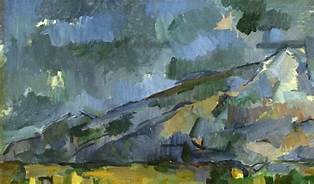Back to Liam’s Going, novel of extraordinary beauty.
What are we talking about this time?
Memory.
What is memory?
I don’t know, but I know how it works in this novel. I call it the music of memory. Three have resonant memories: Cathleen, mother and wife; Noah father and husband; and Antoinette, widow and owner of the Cezanne. A triad, each a different tone and timbre but together a beautiful chord. Minor key, elegiac, because what we remember we no longer have.
Tell the different sounds.
Cathleen’s a Panpipe. In her remembering you hear not just notes but also the breath and the lips passing over the pipes. On slopes above the Hudson River we are really in the land of Eros.
She lay in the arms of her lover only twice and never on a feather bed or any for that matter. Once in an apple barn and a last time in a forgotten graveyard. O what happens when we die, she thought, what happens ever after.
And Noah’s?
A bassoon. His lips a long bent reed away from the wind’s body, but he fingers the stops well. A cautious man but intense, in his youth taught deeply by a French woman.
“Do you love anything?” The French woman had asked years before and, his own son’s age then, he did not know how to answer and for an instant then too all the world suddenly gaped like a dark cavern within him.
Antoinette?
A cello, closest to the human voice. A lament for a lost husband, victim of a belle dame sans merci.
. . . he missed the road too much no matter how much he loved me. He drank himself away eventually, turned so yellow from the jaundice the children called him the Chinaman. Cirrhosis. . . . God he was handsome though, before he turned yellow.
All very sad and sweet, but I never heard of a trio of panpipe, bassoon and cello.
Neither have I. But there you have memory’s chord—love, loss, mystery. And death, without which there can be no poignancy.
A novel of extraordinary beauty.
Click the image below to get the book.
What are we talking about this time?
Memory.
What is memory?
I don’t know, but I know how it works in this novel. I call it the music of memory. Three have resonant memories: Cathleen, mother and wife; Noah father and husband; and Antoinette, widow and owner of the Cezanne. A triad, each a different tone and timbre but together a beautiful chord. Minor key, elegiac, because what we remember we no longer have.
Tell the different sounds.
Cathleen’s a Panpipe. In her remembering you hear not just notes but also the breath and the lips passing over the pipes. On slopes above the Hudson River we are really in the land of Eros.
She lay in the arms of her lover only twice and never on a feather bed or any for that matter. Once in an apple barn and a last time in a forgotten graveyard. O what happens when we die, she thought, what happens ever after.
And Noah’s?
A bassoon. His lips a long bent reed away from the wind’s body, but he fingers the stops well. A cautious man but intense, in his youth taught deeply by a French woman.
“Do you love anything?” The French woman had asked years before and, his own son’s age then, he did not know how to answer and for an instant then too all the world suddenly gaped like a dark cavern within him.
Antoinette?
A cello, closest to the human voice. A lament for a lost husband, victim of a belle dame sans merci.
. . . he missed the road too much no matter how much he loved me. He drank himself away eventually, turned so yellow from the jaundice the children called him the Chinaman. Cirrhosis. . . . God he was handsome though, before he turned yellow.
All very sad and sweet, but I never heard of a trio of panpipe, bassoon and cello.
Neither have I. But there you have memory’s chord—love, loss, mystery. And death, without which there can be no poignancy.
A novel of extraordinary beauty.
Click the image below to get the book.

